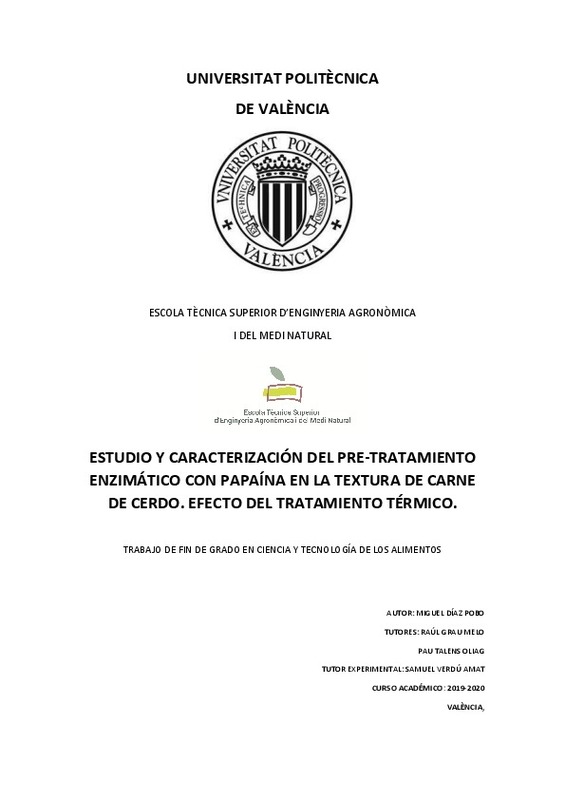|
Resumen:
|
[EN] Some of the physical properties of meat, such as texture or visual appearance, have been studied
from the performance of various experimental techniques, in order to understand better the
effects of the application ...[+]
[EN] Some of the physical properties of meat, such as texture or visual appearance, have been studied
from the performance of various experimental techniques, in order to understand better the
effects of the application of the papain enzyme, whose character proteolytic is well known.
For its realization, commercially sold pork loin was used, which was subsequently prepared in
pieces of approximately 2x2x2cm. The samples were inoculated with the enzyme through a
sequence of injections. Thermic treatment was also carried out on a part of the samples, in order
to study the structural and visual differences between those inoculated and those that were not.
The texture was studied using a TPA compression method of the samples in a specific device
called TA-TX2 texture analyzer. Thermic treated samples were analyzed by the image using the
software Fiji. Sensory analysis was also carried out to evaluate the hardness and appearance of
the samples with heat treatment, which consisted of two tests, a triangular similarity test and
an intensity scale. Moisture determination was carried out by the oven drying method.
With the results it has been possible to appreciate the differences in physical and structural
behavior between the meat that was inoculated and that which was not, as well as the effects
of the heat treatment on the samples. This study may be useful for future applications in
developing meat products with modified texture, specially focused on individuals with eating
disorders or difficulties related to chewing and swallowing food
[-]
[ES] Actualmente existe un gran segmento poblacional como las personas de edad avanzada, con una gran tasa de crecimiento, o más pequeños como aquellos que presentan ciertos trastornos neurológicos o del sistema nervioso ...[+]
[ES] Actualmente existe un gran segmento poblacional como las personas de edad avanzada, con una gran tasa de crecimiento, o más pequeños como aquellos que presentan ciertos trastornos neurológicos o del sistema nervioso provocados por distintas enfermedades (esclerosis múltiple, párkinson, cáncer, accidentes cerebrovasculares, etc), los cuales presentan alteraciones alimentarias derivadas de disfunciones masticatorias y problemas de deglución. Entre otros, estos grupos pueden presentar problemas proteicos por un déficit de consumo de carne a consecuencia de su textura, cuyo impacto se intenta minimizar mediante el triturado de la carne, si bien esto hace que sea menos apetecible y por tanto su consumo sea mínimo.
Es por ello que en el presente trabajo se pretende estudiar y caracterizar el efecto del pretratamiento de carne de cerco con paina, enzima con alta actividad proteolítica, evaluando sus características texturales tras la cocción. Para ello, se llevará a cabo un tratamiento mediante la inyección de una disolución del enzima sobre las muestras de carne fresca de cerdo.
Los efectos del enzima Papaína sobre la textura serán estudiados a través del análisis de textura TPA. Estos se realizarán, tanto para el estado crudo como para el tratado térmicamente. Un estudio de análisis de imagen posterior mediante un software especializado, complementado con un análisis sensorial servirá para correlacionar, si existen, las posibles variaciones de la textura con las diferencias visuales.
Estos estudios podrían servir en un futuro, para la posterior adaptación o desarrollo de productos cárnicos con textura modificada.
[-]
|







